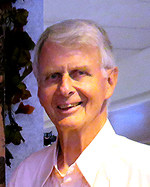 Tales Of Our Times
Tales Of Our Times
By JOHN BARTLIT
New Mexico Citizens
for Clean Air & Water
Campaigns Ably Conceal The Problem As A Whole
Year after year, election ballots list choices in boxes that direct us to “Vote For One”. To train voters in this mindset, election campaigns tell about some mighty problems in the news and say which part of some problem they would fix.
One side campaigns to protect peaceful protest. The other side campaigns to stop the riots, looting, and arson that are seen interrupting peace. The problem we face is how to protect the cherished right to peaceful protest while halting riots, looting, and arson.
One side campaigns to bring more liberty; others campaign to bring more justice. We all know that our nation’s standing pledge concludes, “with liberty and justice for all”. Each of the big parties spotlights words that would fulfill half the pledge. Problems fester when answers use half the factors, or less.
A really large problem in the news is wildfires. Across the American West, wildfires are now harmful enough often enough to fuel ideas for actions that would lower the dangers. Wildfire records were set this year in states as varied as California and Colorado. What could be done better?
Keeping with the election mode, parties respond with the worn banner, “Vote For One.” One big party runs with the “climate change” part. The staunch opposition speaks for the “forest management” part. In fact, the bad fires seen on TV result from combined aspects of climate change, forest management, and changing demographics.
The climate throughout Western timberland is as it is and the trees are as they are. Some parts have changed, to be sure. Reporters at wildfire scenes may cite climate as a reason for some changes that need fixing. Others may report on managing forests to deal better with the present landscape. A useful task is thinning out trees in built-up areas and in other key places. Yet in politics, “thinning” of trees is as quick to divide people as the word “climate.” I will say more about this later.
Meanwhile, the region’s climate is not the only source of change. Pertinent changes stem from the constantly rising population on timberland. Over time, the urban-forest interface reaches farther out and grows longer. More people yearn to leave sprawling cities to be closer to nature. More miles of roads are built, which adds traffic past more trees. More homes are built, needing more power lines routed through trees. Each year, more activities spread into formerly wild places.
Neighbors in these places meet to discuss the pros and cons of thinning some of the trees that drew the people there. Fuels and fire specialists from the Forest Service may attend such meetings and pitch in with the latest findings that forest science draws from all parts of forests.
Forest science describes a healthy forest as resembling forests that horse-drawn wagons could drive through. How would that look? The forest would have maybe 30 or 40 big trees per acre. Forests today have 10 or 50 times more trees than this in all sizes. In short, to restore healthy forests, science has a good deal to say about thinning.
Alas, forests are dark and full of woeful barriers against thinning:
- People do not want to see so much thinning on timberland.
- How much thinning is right?
- Where should thinning be done?
- Who pays for the thinning (vote for one)?
- What should be done with the cut or downed trees?
The problem we face is the whole of these.
These days, politics is dark as a forest, but times can change. In the sunlight, we now have high-tech, high-rise buildings made entirely of wood, or “cross-laminated timber” (CLT) by name. New boons stir in the woods. More trees sequester more carbon: Choose CLT. Since the mid-1990s, builders around the world increasingly use CLT.
Coming here next week is a working column about the science, history, and economics of cross-laminated timber—an economic link between climate change and forest management. Elections come and go (eventually). But many an old problem chugs along like a plague. Our Nation can do better than making wildfires worse by each big party exalting its one-sided halfway fix.

